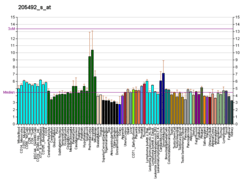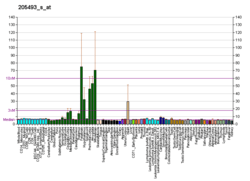DPYSL4
Dihydropyrimidinase-related protein 4 is an enzyme that in humans is encoded by the DPYSL4 gene.[4][5][6]
| DPYSL4 | |||||||||||||||||||||||||
|---|---|---|---|---|---|---|---|---|---|---|---|---|---|---|---|---|---|---|---|---|---|---|---|---|---|
| Identifiers | |||||||||||||||||||||||||
| Aliases | DPYSL4, CRMP3, DRP-4, ULIP4, dihydropyrimidinase like 4 | ||||||||||||||||||||||||
| External IDs | OMIM: 608407 MGI: 1349764 HomoloGene: 4691 GeneCards: DPYSL4 | ||||||||||||||||||||||||
| |||||||||||||||||||||||||
| |||||||||||||||||||||||||
| |||||||||||||||||||||||||
| Orthologs | |||||||||||||||||||||||||
| Species | Human | Mouse | |||||||||||||||||||||||
| Entrez | |||||||||||||||||||||||||
| Ensembl | |||||||||||||||||||||||||
| UniProt | |||||||||||||||||||||||||
| RefSeq (mRNA) | |||||||||||||||||||||||||
| RefSeq (protein) |
| ||||||||||||||||||||||||
| Location (UCSC) | Chr 10: 132.19 – 132.21 Mb | n/a | |||||||||||||||||||||||
| PubMed search | [2] | [3] | |||||||||||||||||||||||
| Wikidata | |||||||||||||||||||||||||
| |||||||||||||||||||||||||
References
- GRCh38: Ensembl release 89: ENSG00000151640 - Ensembl, May 2017
- "Human PubMed Reference:". National Center for Biotechnology Information, U.S. National Library of Medicine.
- "Mouse PubMed Reference:". National Center for Biotechnology Information, U.S. National Library of Medicine.
- Hamajima N, Matsuda K, Sakata S, Tamaki N, Sasaki M, Nonaka M (Jan 1997). "A novel gene family defined by human dihydropyrimidinase and three related proteins with differential tissue distribution". Gene. 180 (1–2): 157–63. doi:10.1016/S0378-1119(96)00445-3. PMID 8973361.
- Byk T, Ozon S, Sobel A (Jul 1998). "The Ulip family phosphoproteins--common and specific properties". Eur J Biochem. 254 (1): 14–24. doi:10.1046/j.1432-1327.1998.2540014.x. PMID 9652388.
- "Entrez Gene: DPYSL4 dihydropyrimidinase-like 4".
Further reading
- Deloukas P, Earthrowl ME, Grafham DV, et al. (2004). "The DNA sequence and comparative analysis of human chromosome 10". Nature. 429 (6990): 375–81. doi:10.1038/nature02462. PMID 15164054.
- Strausberg RL, Feingold EA, Grouse LH, et al. (2003). "Generation and initial analysis of more than 15,000 full-length human and mouse cDNA sequences". Proc. Natl. Acad. Sci. U.S.A. 99 (26): 16899–903. doi:10.1073/pnas.242603899. PMC 139241. PMID 12477932.
- Weitzdoerfer R, Fountoulakis M, Lubec G (2002). "Aberrant expression of dihydropyrimidinase related proteins-2,-3 and -4 in fetal Down syndrome brain". J. Neural Transm. Suppl. (61): 95–107. doi:10.1007/978-3-7091-6262-0_8. ISBN 978-3-211-83704-7. PMID 11771764.
- Fukada M, Watakabe I, Yuasa-Kawada J, et al. (2001). "Molecular characterization of CRMP5, a novel member of the collapsin response mediator protein family". J. Biol. Chem. 275 (48): 37957–65. doi:10.1074/jbc.M003277200. PMID 10956643.
- Inatome R, Tsujimura T, Hitomi T, et al. (2000). "Identification of CRAM, a novel unc-33 gene family protein that associates with CRMP3 and protein-tyrosine kinase(s) in the developing rat brain". J. Biol. Chem. 275 (35): 27291–302. doi:10.1074/jbc.M910126199. PMID 10851247.
- Honnorat J, Byk T, Kusters I, et al. (2000). "Ulip/CRMP proteins are recognized by autoantibodies in paraneoplastic neurological syndromes". Eur. J. Neurosci. 11 (12): 4226–32. doi:10.1046/j.1460-9568.1999.00864.x. PMID 10594648.
External links
This article is issued from Wikipedia. The text is licensed under Creative Commons - Attribution - Sharealike. Additional terms may apply for the media files.



